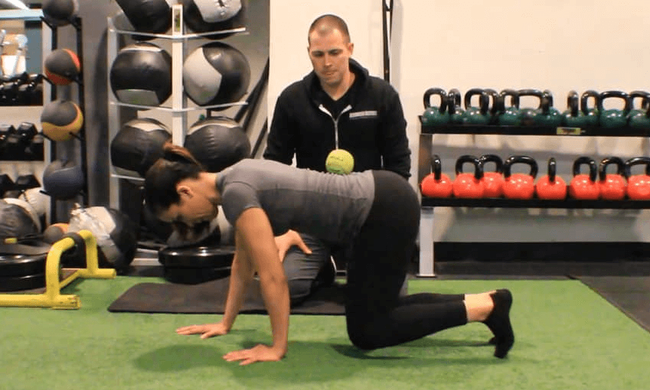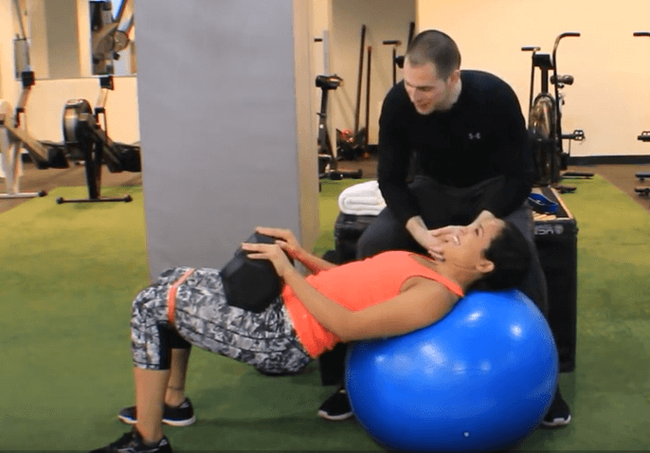Research Review: Effectiveness of Core Muscle Strengthening for Reducing Pain and Improving Balance in Females with Patellofemoral Pain Syndrome
By Tristan J. Rodik, M.AT., ATC
Edited By Brent Brookbush, DPT, PT, COMT, MS, PES, CES, CSCS, ACSM H/FS
Original Citation: Chevidikunnan, M. F., Saif, A. A., Gaowgzeh, R. A., and Mamdouh, K. A. (2016) Effectiveness of core muscle strengthening for improving pain and dynamic balance among female patients with patellofemoral pain syndrome. Journal of Physical Therapy Science, 28, 1518-1523. FULL ARTICLE
Introduction: Studies have shown the gluteus maximus and gluteus medius (gluteal complex ) strengthening is an effective addition to treatment for patellofemoral pain syndrome (PFPS) (1-15). Research also demonstrates, adding core strengthening (rectus abdominis , external obliques , and paraspinals ) to gluteal complex strengthening may provide additional benefits (13, 15). This 2016 study by Saudi Arabian researchers demonstrates that core strengthening combined with conventional physical therapy (general hip and knee strengthening program) can reduce pain and improve balance in females with PFPS. This study reinforces the positive impact core exercise has on outcomes for this dysfunction.

Study Summary
| Study Design | Experimental study |
| Level of Evidence | IIB Evidence from at least one other type of quasi-experimental study |
| Participant Characteristics |
Demographics Control Group: Conventional Physical Therapy
Experimental Group: Core Strengthening Physical Therapy
Inclusion Criteria:
Exclusion Criteria:
|
| Methodology |
Experimental Group
Control Group
|
| Data Collection and Analysis |
|
| Outcome Measures |
|
| Results | Visual Analog Scale (VAS)
Star Excursion Balance Test (SEBT)
|
| Our Conclusions | This study demonstrates that core, gluteal complex, and quadriceps strengthening improves self-reported pain and dynamic balance in females with PFPS. Further, the addition of core exercise may provide additional benefits to conventional hip and knee strengthening programs. These findings are congruent with the Brookbush Institute’s integrated approach, which includes gluteal complex and core activation for individuals with Lower Extremity Dysfunction (LED), including those with symptoms of PFPS. |
| Researchers' Conclusions
|
The results of this study offer an approach for addressing PFPS. The findings demonstrate that combining core muscle strengthening and conventional physical therapy helps reduce pain intensity and improve dynamic balance in females with PFPS. |

Ultimate Glute Bridge
How This Study Contributes to the Body of Research:
A decrease in core reactivity and less glute complex strength have been correlated with increased risk of knee injury (16, 17). This study compared a conventional program (hip and knee strengthening) to the same program with additional core strengthening for the treatment of PFPS (5, 6, 10, 11, 13, 15). Further, this study added balance as an outcome measure, using the STAR excursion balance. The outcomes suggest that the addition of core strengthening to a conventional 4-week can program can significantly improve self-reported pain as well as balance parameters.
How the Findings Apply to Practice:
The study demonstrates a relationship between the intent to increase core muscle strength, endurance, and/or stability, and the resolution of symptoms of patellofemoral pain syndrome (PFPS). Human movement professionals should consider integrating core exercise into PFPS programs. Further, although little research exists to support the reliability of core assessments, assessing the core, adding the STAR excursion balance test, and/or monitoring improvements made during core exercises should be considered.
This study had many methodological strengths, including:
- The exercises and balance assessments used in the study required minimal equipment, allowing human movement professionals to easily incorporate them into practice.
- Researchers were blinded to participants’ group allocation, enhancing the validity of the results.
- Methods for the core strengthening exercises were clearly described, enhancing clinical applicability.
- Comparing the addition of core exercise to a well thought-out program, added to the clinical significance of the study.
Weaknesses that should be noted prior to clinical integration:
- A female-only cohort limits the generalizability of the study.
- The lack of electromyography (EMG) and manual muscle testing makes comparison to other studies on this topic difficult.
- The lack of follow-up results in questions regarding the efficacy of the addition of core exercise for reducing PFPS long-term.
How this Study Relates to Brookbush Institute Content:
The positive outcomes demonstrated with the addition of core exercise to gluteal complex and quadricep strengthening for self-reported pain and dynamic balance in females with PFPS supports several assertions/assumptions made in the Brookbush Institutes' (BI) predictive models of Lower Extremity Dysfunction (LED) , Lumbopelvic Hip Complex Dysfunction (LPHCD) and Sacroiliac Joint Dysfunction (SIJD) . This includes assertions about regional interdependence, the benefits of integrated practice, the benefits of core stability exercise, and the effect integrated practice can have on performance outcomes like balance. The program used in the experimental group of this study more closely resembled a BI corrective intervention; however, the BI recommends starting all programs with appropriate mobility techniques.
The following videos illustrate exercise techniques for core strengthening:
Sample Videos Related to the Research Content:
Quadruped with Glute Activation
Standing Chop Pattern
The Ultimate Glute Bridge
Recommended Readings:
- Panel Discussion: Increasing glute activity, recruitment, endurance and strength.
- Panel Discussion: Core function and performance.
Bibliography:
- Boling, M. C., Padua, D. A. and Creighton, R. A. (2009) Concentric and eccentric torque of the hip musculature in individuals with and without patellofemoral pain. Journal of Athletic Training, 44(1), 7-13
- Ramskov, D., Barton, C., Nielson, R. O. and Rasmussen, S. (2015) High eccentric hip abduction strength reduces the risk of developing patellofemoral pain among novice runners initiating a self-structured running program: a 1-year observational study. Journal of Orthopaedic and Sports Physical Therapy, 45(3), 153-161
- Bolgla, L. A., Malone, T. R., Umberger, B. R. and Uhl, T. L. (2008) Hip strength and hip and knee kinematics during stair descent in females with and without patellofemoral pain syndrome. Journal of Orthopaedic and Sports Physical Therapy, 38(1), 12-18
- Bolgla, L. A., Malone, T. R., Umberger, B. R. and Uhl, T. L. (2011) Comparison of hip and knee strength and neuromuscular activity in subjects with and without patellofemoral pain syndrome. The International Journal of Sports Physical Therapy, 6(4), 285-296
- Dolak, K. L., Silkman, C., Medina McKeon, J., Hosey, R. G., Lattermann, C. and Uhl, T. L. (2011) Hip strengthening prior to functional exercises reduces pain sooner than quadriceps strengthening in females with patellofemoral pain syndrome: a randomized clinical trial. Journal of Orthopaedic and Sports Physical Therapy, 41(8), 560-570
- Baldon, R. D. M., Serrao, F. V., Silva, R. S. and Piva, S. R. (2014) Effects of functional stabilization training on pain, function, and lower extremity biomechanics in women with patellofemoral pain: a randomized clinical trial. Journal of Orthopaedic and Sports Physical Therapy, 44(4), 240-A8
- Nakagawa, T. H., Moriya, E. T. U., Maciel, C. D. and Serrao, F. V. (2012) Frontal plane biomechanics in males and females with and without patellofemoral pain. Medicine in Science and Exercise, 44(9), 1747-1755
- Cowan, S. M., Crossley, K. M. and Bennell, K. L. (2009) Altered hip and trunk muscle function in individuals with patellofemoral pain. British Journal of Sports Medicine, 43, 584-588
- Esculier, J. F., Roy, J. S. and Bouyer, L. J. (2015) Lower limb control and strength in runners with and without patellofemoral pain syndrome. Gait and Posture, 41(3), 813-819
- Saad, M. C., Vasoncelos, R. A., Mancinelli, L. V. O., Munno, M. S. B., Liporaci, R. F. and Grossi, D. B. (2018) Is hip strengthening the best treatment option for females with patellofemoral pain? A randomized controlled trial of three different types of exercises. Brazilian Journal of Physical Therapy, doi: 10.1016/j/bjpt.2018.03.009
- Nascimento, L. R., Teixeria-Salmela, L. F., Souza, R. B and Resende, R. A. (2018) Hip and knee strengthening is more effective than knee strengthening alone for reducing pain and improving activity in individuals with patellofemoral pain: a systematic review with meta-anlaysis. Journal of Orthopaedic and Sports Physical Therapy, 48(1), 19-31
- Nunes, G. S., Barton, C. J. and Serrao, F. V. (2018) Hip rate of force development and strength are impaired in females with patellofemoral pains without signs of altered gluteus medius and maximus morphology. Journal of Science and Medicine in Sport, 21(2), 123-128
- Bolgla, L. A., Earl-Boehm, J., Emery, C., Hamstra-Wright, K. and Ferber, R. (2016) Pain, function, and strength outcomes for males and females with patellofemoral pain who participate in either hip/core- or knee-based rehabilitation programs. International Journal of Sports Physical Therapy, 11(6), 926-935
- Almeida, G. P., Silva, A. P., Franca, F. J., Magalhaes, M. O., Burke, T. N. and Marques, A. P. (2016) Relationship between frontal plane projection angle of the knee and hip and trunk strength in women with and without patellofemoral pain. Journal of Back and Musculoskeletal Rehabilitation, 29(2), 259-266
- Carry, P. M., Gala, R., Worster, K., Kanai, S. Miller, N. H., James, D., Provance, A. J. and Carollo, J. J. (2017) Postural stability and kinetic change in subjects with patellofemoral pain after a nine-week hip and core strengthening program. The International Journal of Sports Medicine, 12(3), 314-323
- Chuter, V. H. and Janse de Jonge, X. A. (2012) Proximal and distal contributions to lower extremity injury: a review of the literature. Gait and Posture, 36(1), 7-15
- Willson, J. D., Kernozek, T. W., Arndt, R. L., Reznichek, D. A. and Scott Straker, J. (2011) Gluteal muscle activation during running in females with and without patellofemoral pain syndrome. Clinical Biomechanics, 26(7), 735-740
© 2018 Brent Brookbush
Questions, comments, criticisms are welcomed and encouraged.


